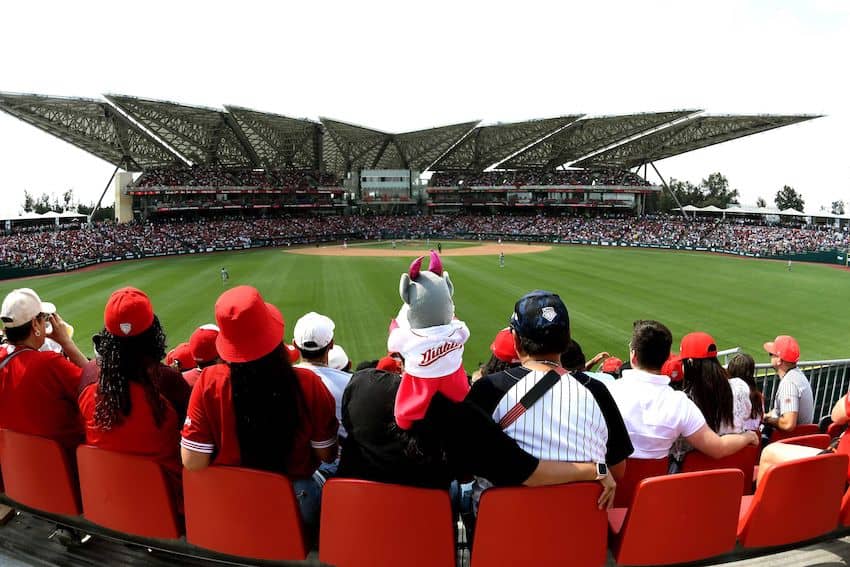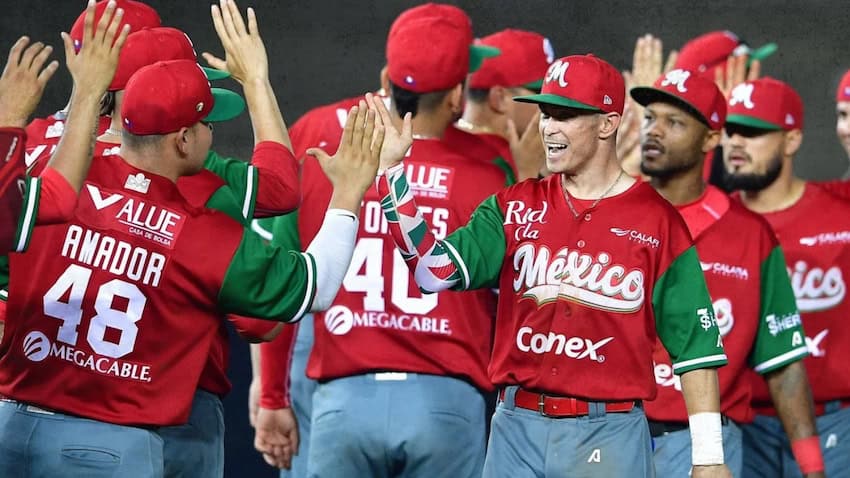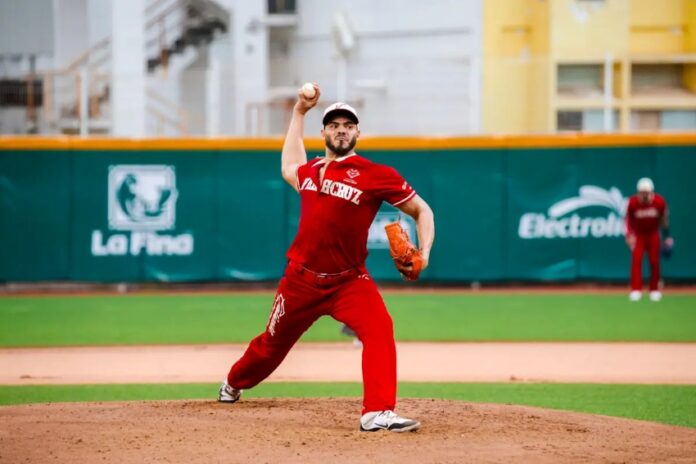There aren’t many sporting experiences that rival a summertime ballgame at the park. That’s certainly true in the United States — but it’s also evident in Mexico, where the sport has been a fan favorite since it arrived, likely during the Mexican-American War, with many citing the exact year as 1847.
The nation’s bountiful fandom and history will be on display for the Liga Mexicana de Béisbol’s (LMB) Juego de Estrellas (the league’s All-Star Game) from June 27 to 29 at Estadio Alfredo Harp Helú in Mexico City, home of the defending national champions and winningest franchise in league history, Diablos Rojos.

The weekend will include a selection of the top 68 baseballers, spanning the league’s 20 teams, divided evenly by the North Zone and South Zone (i.e. league divisions) in a match-up taking place on June 29. The headliner game will be preceded by a celebrity match and a home run derby on June 28. Times and ticket prices vary, but start as low as US $15.
In the galaxy of international baseball, Mexico has positioned itself as an attractive landing spot for both veteran and hopeful baseball players alike, with players in the Liga Mexicana de Béisbol (LMB) hailing from nations like the United States, the Dominican Republic, Cuba, Puerto Rico, Venezuela, Japan, South Korea and, of course, all of Mexico.
What to expect at the LMB All-Star game
Though the event occurs annually, this year’s festivities are offering more than the usual variety. For starters, the LMB is currently celebrating its centennial season with year-long homages, events and limited-edition fan merchandise that showcase Mexico’s 100-year professional baseball tradition.
Accordingly, this year’s Juego de Estrellas will feature La Gala del Centenario — a special event on Friday, June 27 that will honor the best moments of the past 100 LMB years.
The 2025 centennial edition of this all-star showdown will also introduce a new format: For the first time ever, the LMB’s best players will compete in a 10-inning tilt against Mexico’s national team — who placed third overall in the 2023 World Baseball Classic, an all-time best finish for the nation. Each inning will represent one of the 10 decades in the LMB’s existence.
On top of that, the game will be hosted at the hypermodern — if not futuristic-looking — Harp Helú stadium (capacity: 20,062) for the first time since the stadium originally debuted in 2019. Before the US $160 million stadium was built, the Mexican baseball powerhouse Diablos Rojos played at Estadio Fray Nano (2018-2015), Foro Sol (2014-2000) and Parque del Seguro Social (1999-1940).

The Harp Helú is housed near the Benito Juarez International Airport (AICM) as part of Ciudad Deportiva (Sports City) — a sprawling sports park complex that also features the Autódromo Hermanos Rodríguez, a ritzy F1 race track also often used for Mexico City concerts by major musical artists.
It’s the 33rd time that the capital will host the Juego de Estrellas, and the nation’s 91st all-star event.
The first Juego de Estrellas took place in 1939, then went on hiatus during World War II, and resumed in 1942, occurring during every consecutive season to date. Last year’s celebration took place at Estadio Beto Ávila in the port of Veracruz — the comparatively smaller and charming home of El Águila de Veracruz, which is the league’s oldest continuously operating franchise.
The Veracruz stadium, incidentally, is one of only two in the entire continent featuring a swimming pool for fans to watch the game from the outfield stands; the other is located at Chase Field in Phoenix, where the MLB’s Arizona Diamondbacks play. Though Mexico City’s baseball sanctuary unfortunately doesn’t offer a pool, it’s known for its expansive fan offerings, Aztec-inspired architecture and overall quality, which Major League Baseball has graded as “an ultramodern facility.”
Mexico’s baseball league is currently experiencing a swell in its fandom. With more ex-Major Leaguers playing than ever before — due to a rule change allowing up to 20 international players per 38-man roster — there is a renewed interest in “El Rey de Deportes,” or the King of Sports, as the league is colloquially known.
High-profile players like Robinson Cano and Yasiel Puig have recently passed through — or are currently still playing in — the pro Mexican baseball circuit. The fervor has certainly reached a new pitch: Yahoo! Sports reported that a few Mexican League teams are drawing larger average crowds than some of Mexico’s biggest soccer clubs.
For U.S.- and international-born players, Mexico is also becoming a viable route with decent salaries, proximity to the Majors and a decently competitive league that current players are referring to as “4-A” ball (alluding to the MLB’s Triple A, Double A and Single A farm system). And with new online shows like LMB Strike Zone, which target a new generation of fans, baseball is regaining the cultural cachet and coolness it once had.
Historically, Mexico’s league has been considered to be a lower-tier professional circuit, offering opportunities to former MLB stars and prospects who have fallen out of favor on more prominent U.S. teams. With over 140 Mexican-born players having crossed the border northward into the MLB, the LMB has been a starting point for U.S. baseball icons like Bobby Avila and Fernando Valenzuela, whose careers began on regional Mexican teams before making the leap to the Boston Red Sox and Los Angeles Dodgers, respectively.
Indeed, historic Mexican teams like the aforementioned Diablos Rojos, the Sultanes de Monterrey, the Tigres de Quintana Roo and El Águila de Veracruz have helped to launch, or sustain, such historic careers. Meanwhile, the LMB’s growth continues to introduce new expansion teams and broaden its fan base.
Of course, the Mexican League’s tenure hasn’t all been home runs and fireworks. In 2020, the Mariachis de Guadalajara were announced by then-national president Andrés Manuel López Obrador as the latest franchise to join the LMB’s ranks as a symbol of Mexico’s cultural pride and heritage. Just a few seasons later, the team’s players refused to take the field in a series against Sultanes de Monterrey as a protest against not receiving their contractually agreed-upon payments; shortly afterward, the team was again accused of financial mismanagement and then sold off in 2023.
But the Juego de Estrellas is about putting on a show and looking toward the game’s future, so only the league’s best will be at bat, with a historic focus on the league’s most prominent players and successes.

Getting to Harp Helú Stadium
Expect traffic and large crowds. The nearby Metro station drops you off about a quarter mile from the stadium’s front entrance (the walk is lively and crowded with fans, street food, bootleg merchandise, and more — an experience in itself).
If you prefer to take an Uber or taxi, ask to be dropped off near the stadium stop — you will know when you’re close because everyone will be suddenly wearing baseball gear, and the taxi will lurch to a stop with nowhere to go due to the high concentration of traffic and pedestrians entering the sports complex.
Once inside, there’s a baseball museum dedicated to the Diablos Rojos and an impressive selection of food items. The stadium’s famous tacos de cochinita pibil can be found to the left of the main entrance at Los Famosos del Béisbol, a concession stand with a perennially long wait for an order of Yucatán-style tacos that reportedly have been served at Diablos Rojos by the same family for over 70 years.
If you haven’t been to a baseball game in Mexico yet (or any professional sporting event, for that matter), don’t strike out on this year’s Juego de Estrellas, which promises to be a memorable experience.
Alan Chazaro is the author of “This Is Not a Frank Ocean Cover Album,” “Piñata Theory” and “Notes From the Eastern Span of the Bay Bridge” (Ghost City Press, 2021). He is a graduate of June Jordan’s Poetry for the People program at UC Berkeley and a former Lawrence Ferlinghetti Fellow at the University of San Francisco. His writing can be found in GQ, NPR, The Guardian, L.A. Times and more. Originally from the San Francisco Bay Area, he is currently based in Veracruz.
